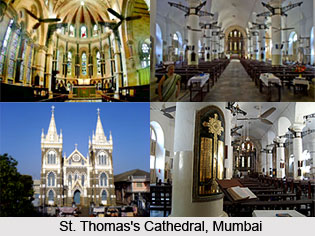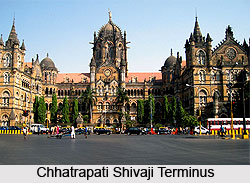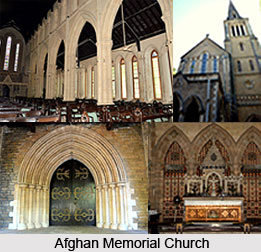 British monuments in Mumbai were constructed as the result of the rule of the British East India Company and later the rule of the British crown which ruled India. With the rise of British rule under the East India Company and the Raj, there was a major unifying influence which helped to counterbalance the tendency towards political and social fragmentation. In many ways the history of India can be seen as the perpetual interaction between central and regional authority and between cohesive and fragmentary forces.
British monuments in Mumbai were constructed as the result of the rule of the British East India Company and later the rule of the British crown which ruled India. With the rise of British rule under the East India Company and the Raj, there was a major unifying influence which helped to counterbalance the tendency towards political and social fragmentation. In many ways the history of India can be seen as the perpetual interaction between central and regional authority and between cohesive and fragmentary forces.
In the year 1661, the British East India Company acquired Mumbai (Bombay) as part of the dowry of Catherine of Braganza when she married Charles II, but as it was notorious for its insalubrious climate, for many years it remained subordinate to Surat. In Mumbai (Bombay) the construction of a spectacular New Greek town hall was started in the year 1820, the finest neo-classical building in India. St. Thomas`s Cathedral, Mumbai, St Mary`s, and St George`s, Chennai (Madras) and St John`s, Kolkata (Calcutta), have outstanding collections of mural monuments which should not be missed.
 After the painful events of the Sepoy Mutiny, the balance of British commercial interests changed. Kolkata remained pre-eminent, but Chennai became less important. The centre of activity shifted to the west coast and to the emerging city of Mumbai, which in less than three decades exploded from a forgotten backwater to a great Imperial city. The speedy growth and development of the Mumbai city in the state of Maharashtra was phenomenal. In the year 1864, there were thirty one banks, sixteen financial associations and sixty-two joint stock companies and all these were not there just nine years earlier. This sudden economic boom owed much to the slump in supplies of American cotton to the Lancashire textile mills on the outbreak of the American Civil War. Overnight the city of Mumbai became `Cottonopolis`, a vast clearing-house for meant for Indian produce. Prices also climbed to staggering levels and the values of land rose fourfold. Speculation in land became frenetic.
After the painful events of the Sepoy Mutiny, the balance of British commercial interests changed. Kolkata remained pre-eminent, but Chennai became less important. The centre of activity shifted to the west coast and to the emerging city of Mumbai, which in less than three decades exploded from a forgotten backwater to a great Imperial city. The speedy growth and development of the Mumbai city in the state of Maharashtra was phenomenal. In the year 1864, there were thirty one banks, sixteen financial associations and sixty-two joint stock companies and all these were not there just nine years earlier. This sudden economic boom owed much to the slump in supplies of American cotton to the Lancashire textile mills on the outbreak of the American Civil War. Overnight the city of Mumbai became `Cottonopolis`, a vast clearing-house for meant for Indian produce. Prices also climbed to staggering levels and the values of land rose fourfold. Speculation in land became frenetic.
This accumulation of exceptional wealth coincided with the arrival of a new Governor, Sir Bartle Frere. Under his guidance and energetic direction the city was modeled to be the Gateway of India. The old town walls were swept away. A totally new city began to take shape in the latest fashionable Gothic style. Frere was determined to give the city a series of public buildings worthy of its wealth, power and potential. He stipulated that the designs should be of the highest architectural caliber, with conscious thought given to aesthetic impact.
 In Mumbai, in a great phalanx facing the Maidan lie the Secretariat, University Library and Convocation Hall, the Rajabai Tower, the Law Courts, Public Works Office and Telegraph Office; `a truly Imperial vision, monolithic, awe-inspiring and supremely self-confident`. Today, due to land reclamation, they no longer face out across the sea, but they coalesce to form a splendid romantic skyline. The first church in India to be designed as per the new principles of correct Gothic architecture, laid down by Pugin and the Ecclesiological Society, was the Afghan Memorial Church of St John the Evangelist at Colaba in Mumbai, commenced in the year 1847. Its tall spire was a local landmark and its revolutionary principles infected the city with an enthusiasm for Gothic architecture which continued for over fifty years.
In Mumbai, in a great phalanx facing the Maidan lie the Secretariat, University Library and Convocation Hall, the Rajabai Tower, the Law Courts, Public Works Office and Telegraph Office; `a truly Imperial vision, monolithic, awe-inspiring and supremely self-confident`. Today, due to land reclamation, they no longer face out across the sea, but they coalesce to form a splendid romantic skyline. The first church in India to be designed as per the new principles of correct Gothic architecture, laid down by Pugin and the Ecclesiological Society, was the Afghan Memorial Church of St John the Evangelist at Colaba in Mumbai, commenced in the year 1847. Its tall spire was a local landmark and its revolutionary principles infected the city with an enthusiasm for Gothic architecture which continued for over fifty years.
The architectural models for the great public buildings of Mumbai were the Victorian Gothic buildings then in the course of construction in London. The designs were readily available to the local military engineers of the Public Works Department in the pages of professional journals like the Builder. George Gilbert Scott, who designed the university buildings in the city from his office in London, Offered a clear source of inspiration for many.
 The Victoria Terminus, Mumbai, or VT, as it is famously known, is the finest Victorian Gothic buildings in India. Constructed between the years 1878 to 1887, it was inspired by Scott`s St Pancras Station, but it is a highly original work, rooted firmly in the High Victorian Gothic tradition. Mumbai had been in the forefront of railway building. The Great Indian Peninsular Railway reached Thane in the year 1853, and the railway system played a major role in the economic success of the city, particularly after the opening of the Suez Canal in the year 1879. Mumbai VT is a `paean of praise to the railway, the supreme example of tropical Gothic architecture; a riotous extravaganza to polychromatic stone, decorated tiles, marble and stained glass`. The colossal masonry dome over the huge internal staircase is crowned by a symbolic statue of progress. Flanking the main entrance stand the Imperial lion and the Indian tiger, twin sentinels of the Raj.
The Victoria Terminus, Mumbai, or VT, as it is famously known, is the finest Victorian Gothic buildings in India. Constructed between the years 1878 to 1887, it was inspired by Scott`s St Pancras Station, but it is a highly original work, rooted firmly in the High Victorian Gothic tradition. Mumbai had been in the forefront of railway building. The Great Indian Peninsular Railway reached Thane in the year 1853, and the railway system played a major role in the economic success of the city, particularly after the opening of the Suez Canal in the year 1879. Mumbai VT is a `paean of praise to the railway, the supreme example of tropical Gothic architecture; a riotous extravaganza to polychromatic stone, decorated tiles, marble and stained glass`. The colossal masonry dome over the huge internal staircase is crowned by a symbolic statue of progress. Flanking the main entrance stand the Imperial lion and the Indian tiger, twin sentinels of the Raj.
Wittet was a more committed Orientalist, who was responsible for the Prince of Wales Museum and also the great Gateway to India, which became an architectural metaphor for the entire city of Mumbai and the symbolic point of departure for the last British troops to leave India after independence.



















